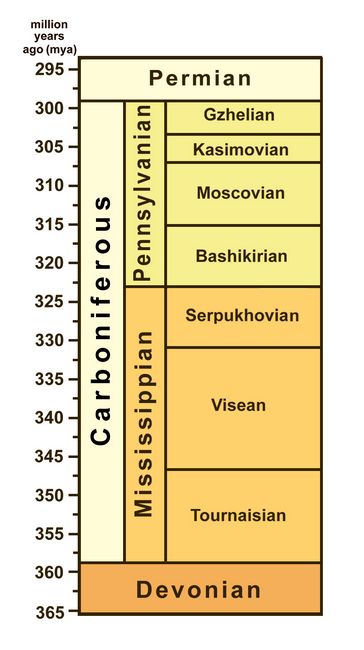Athena Review Image Archive ™
Carboniferous timeline

Timeline for the Carboniferous (chart: Athena Review)
The Carboniferous era contains the fifth and sixth geological periods in the Paleozoic era, dating between 359 – 298.9 mya. The Early Carboniferous (359-323 mya) is known as the Mississippian in North America. The Mississippian has three stages, equivalent to Lower, Middle, and Upper intervals: the Tournaisian (358.9 - 346.7 mya); the Visean (346.7 - 330.9 mya); and the Serpukhovian (330.9 - 323.2 mya).
The North American Late Carboniferous (323.2- 298.9 mya) is the Pennsylvanian period, which includes four stages, the Bashkirian (323.2 - 315.2 mya), Moscovian (315.2 - 307.0 mya), Kasimovian (307.0 - 303.7 mya), and Gzhelian (303.7 - 298.9 mya).
During the Mississippian period in North America, plate tectonics and orogeny (collision of continental plates) created the Appalachian Mountains. The Mississippian period saw a radiation of land vertebrates, with a great diversification of amphibians, including many large carnivores as well as plant eaters, and the first appearance of Reptilomorphs, or reptile-like amphibians.
The Pennsylvanian was a relatively warm period with an expansion of ferns and coniferous forests, whose legacy included vast coal fields and petroleum deposits. Reptilomorphs evolved into the earliest reptiles, including early synapsids.
In
the Carboniferous Period of the Eastern Hemisphere, in northern regions
most of the land areas were transgressed by shallow seas,
resulting in extensive carbonate deposits now turned into marine
imestones. Only higher areas such as the Fennoscandian and
Laurentian Shields remained above sea level, surrounded by river delta
systems and lagoons.
References
Clack, Jennifer 2012. Gaining Ground
.Copyright © 1996-2020 Rust Family Foundation (All Rights Reserved).